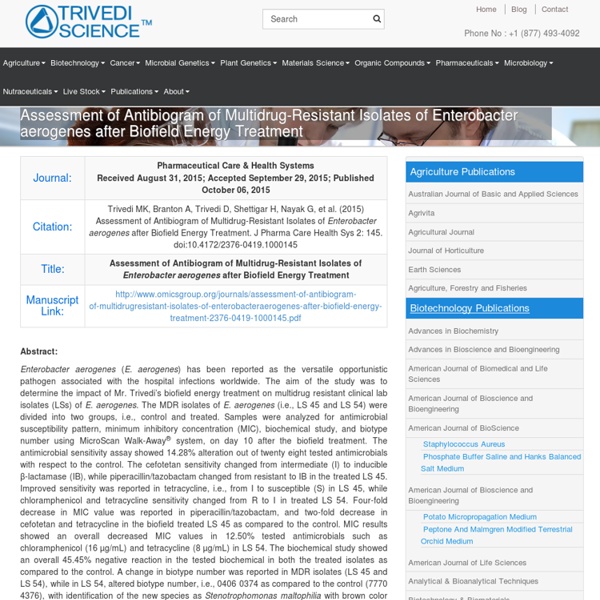



Thermal Analysis (TGA/DTA, DSC) for Biofield Evaluation There Are Lots Of Exciting Things Happening Here At Trivedi Science. Enter Your Email Address In The Box Below Now To Stay Updated! Thermal Analysis (TGA / DTA, DSC) Hanks Balanced Salt Solution - An Evaluation of Biofield Treatment Comparative Physicochemical Evaluation of Biofield Treated Phosphate Buffer Saline and Hanks Balanced Salt Medium Phosphate buffer saline (PBS) has numerous biological and pharmaceutical applications. Hank buffer salt (HBS) has been used as a medium for tissue culture applications.
Human Energy Treatment for Increasing Tomato Yield Abstract: Recent studies report the effect of biofield treatment on changes in structural characteristics of organic and inorganic matter, on cancer cells in vitro and on overall plant development. This study tested the impact of the same treatment applied to lettuce and tomato seeds and transplants (Lactuca sativa var. capitata and Lycopersiconesculentum var. XRD Analysis Technique - Evaluation of Biofield Energy The results obtained on various metallic, ceramic and polymer powders given in subsequent pages are inconceivable and indicate the following facts; 1. Mr.Trivedi’s thought transmission had changed the distance between atoms in the unit cell of a crystal to a maximum of 3.9% and minimum of 0.66 % while the unit cell volume showed a maximum change of 7.79% and a minimum of 1.86%. This means that the powder particle is either elongated or compressed by an amount greater than 0.2% which is normally considered as elastic limit for most solids. These results indicate that the crystal unit cell had undergone permanent compression or elongation (plastic deformation) without changing its structure which is impossible as per current knowledge.
Investigation of antimicrobial susceptibility of E. cloacae Abstract Soybean production in Iowa USA is among the most productive for raínfed regions in the world. Despite generally having excellent soils, growing season temperatures and rainfall, soybean yields are decreased by weed interference and inadequate available soil water at key stages of crop development. A field study was conducted at two locations in lowa in 2012 to determine if seed-applied fungicide or biofield treatments influenced weed community, soil volumetric water concentration and soybean yield and quality. Evaluation of Phenotype and Genotype of Enterobacter Aerogenes Abstract Enterobacter aerogenes (E. aerogenes) has been commonly described as a versatile opportunistic pathogen in hospital infections. The aim of the present work was to evaluate the impact of biofield treatment on E. aerogenes for its phenotypic and genotypic characteristics. E. aerogenes bearing ATCC 13048 (American Type Culture Collection) was procured from Bangalore Genei, in sealed pack and divided into control and treated groups. Treated group was subjected to Mr. Trivedi’s biofield treatment and analyzed for antimicrobial susceptibility, minimum inhibitory concentration (MIC), biochemical reactions, and biotype using automated MicroScan Walk-Away® system.
The Trivedi Effect Impact on Patchouli Plant Cultivation Patchouli (Pogostemon cablin) Control Aromatic plant Treated With The Trivedi Effect® Aromatic plant In a plot area of 64 feet x 8 feet, 100 treated plants of Patchouli (Aromatic plant) were planted. Study of Antimicrobial susceptibility of S. Marcescens Abstract Serratia marcescens (S. marcescens) is Gram-negative bacterium, associated with hospital-acquired infections (HAIs), especially urinary tract and wound infections. The present study was aimed to evaluate the impact of biofield treatment on phenotyping and genotyping characteristics such as antimicrobial susceptibility, biochemical reactions, biotype, DNA polymorphism, and phylogenetic relationship of S. marcescens (ATCC 13880). The lyophilized cells of S. marcescens were divided into three groups (G1, G2, and G3). Control group (G1) and treated groups (G2 and G3) of S. marcescens cells assessed with respect to antimicrobial susceptibility, and biochemical reactions. In addition to that, samples from different groups of S. marcescens were evaluated for DNA polymorphism by Random Amplified Polymorphic DNA (RAPD), and 16S rDNA sequencing in order to establish the phylogenetic relationship of S. marcescens with different bacterial species.
Multidrug Resistant Isolates of Pseudomonas Aeruginosa Abstract In recent years, prevalence of multidrug resistance (MDR) in Pseudomonas aeruginosa (P. aeruginosa) has been noticed with high morbidity and mortality. Aim of the present study was to determine the impact of Mr. Trivedi’s biofield treatment on MDR clinical lab isolates (LS) of P. aeruginosa.
How to Grow Ginseng Pacific Ag Research is the premiere agricultural consulting and contract research organization in the US, which conducts research for some of the topmost agricultural producers worldwide and also handles US government projects. Using their established research methodology, top scientists from Pacific Ag carried out an investigative study to determine “The Trivedi Effect®” on crop development and yields.Two of the selected crops were ginseng and blueberry, grown organically in plantations in California, USA. Ginseng Treated ginseng was subjected to Mr. Trivedi’s Biofield energy in one of three different ways, either once about 3 months before harvest, or once post-harvest before the further processes of cleaning and drying, which took a period of about 12 days. The third group was treated twice, both pre-harvest and post-harvest.
Antimicrobial Sensitivity of Staphylococcus Saprophyticus Abstract Staphylococcus saprophyticus (S. saprophyticus) is a frequent cause of urinary tract infection in the young women. The current study was designed to analyze the effect of biofield energy treatment on S. saprophyticus for evaluation of its antibiogram profile, biochemical reactions pattern and biotyping characteristics. Potential Impact of Biofield on HIV Viral Load Test Abstract Viral load quantification is the amount of particular viral DNA or RNA in a blood samples. It is one of the surrogate biomarker of AIDS. High viral load indicates that the immune system is failed to fight against viruses. The aim of this study was to evaluate the impact of biofield treatment on HIV-1 and HCMV in terms of viral loads as surrogate marker. The viral load assay was performed on stored stock cultures of HIV infected human plasma samples before and after 7 days of biofield treatment using Roche COBAS® AMPLICOR analyzer.